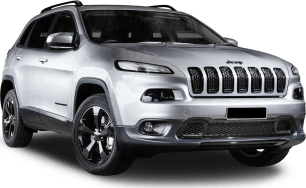There's still plenty to appreciate the instant you slide yourself on to those lofty cushions.
The Vitara is packaged to transport a smaller family (and include much of their clobber) with ease, from the moment the big doors open. An excellent driving position that inspires confidence, heaps of storage in the doors and centre console, good vision and a light and airy ambience are further drawcards.
And while the seats may seem a bit wide and flat to begin with, they're amply supportive over an extended time in them, with a softness to their shape and texture that makes them quite cosy. No lumbar support for the driver is disappointing, though.
Still, it’s easy to see why the Suzuki remains such a consistent seller after all these years without change.
In 2021, the dash has held up pretty well, mainly due to clear instrument dials and Suzuki’s ever-present 7.0-inch touchscreen multimedia system that is ridiculously easy to operate. Never mind the hard and cheap-looking lower-lying plastics, the cabin is beautifully screwed together as well. And it's likely to stay that way for a very long time.
But there are annoyances, beginning with the lack of digital speedometer, especially now that the cheapest Vitara is a near-$30K proposition; for the same reason we’d have hoped for a DAB+ digital radio, auto lights on, rear-seat cupholders and more than just one USB port (located under the climate control system).
Getting in and out of the rear seat is simple, aided by wide doors and lofty seating, again on flat but ultimately comfortable cushions and backrest, though they neither slide or recline as with some other small SUVs. There's heaps of headroom; the raised rear cushion promotes a natural posture which is good for longer journeys, and enough room for three smaller adults to squeeze in. Larger feet can be tucked underneath the front seats too.
However, besides there being no device-charging facilities, you’ll also notice the lack of reading lights, rear air vents (though the front outlets' outputs do reach back OK) and beverage storage. At least the doors have space for a one-litre bottle and the overhead grab handles include coat hooks. And, like the front, it's all light and airy, with good sight lines for bored back-seat riders to stare out from.
Beyond that, the boot is fairly big and square, with a bi-level floor that’s good for hiding smaller items, while there are hooks, a light and 120V outlet for rear-seat occupants to snake some hapless charger cord to.
Cargo capacity is rated at 375 litres – raising to 710L with the 60/40 rear backrests lowered. It’s nice to see a good old-fashioned luggage board instead of the flimsy mesh items some rivals foist upon us nowadays.
All in all, a big, spacious and inviting interior that’s big on practicality and ease, but also showing its age in a few places.

















































 copy.png)




.png)







